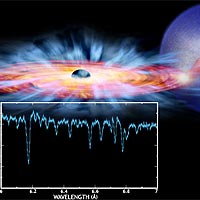Wire Maze Electricity DIY STEM Kit
$9.99$4.95
Posted on: Jun 22, 2006

A team of astronomers led by the University of Michigan may know how black holes are lighting up the Universe. New data from NASA's Chandra X-ray Observatory show, for the first time, that powerful magnetic fields are the key to these brilliant and startling light shows.
It is estimated that up to half of the total radiation in the universe since the Big Bang comes from material falling towards super-massive black holes, including those powering quasars, the brightest known objects. For decades, scientists have struggled to understand how black holes, the darkest objects in the Universe, can generate such prodigious amounts of radiation.
New X-ray data from Chandra give the first clear explanation for what drives this process: magnetic fields. Chandra observed a black hole system in our galaxy, known as GRO J1655-40 (J1655, for short), where a black hole was pulling material from a companion star into a disk.
'By intergalactic standards, J1655 is in our backyard so we can use it as a scale model to understand how all black holes work, including the monsters found in quasars,' said Jon Miller, assistant professor at U-M, whose paper on these results appears in this week's issue of the journal Nature.
If gas in a disk around a black hole loses energy, it will swirl toward the black hole, generating light along the way. Scientists have long thought that magnetic fields may drive this energy loss by generating friction in the gas and driving a wind from the disk that carries momentum outward, in an example of conservation of momentum.
By using Chandra spectra, that is, the amount of X-rays at different energies, Miller and his team showed that the speed and density of the wind from the disk in J1655 corresponded to computer simulation predictions for winds driven by magnetic fields. The spectral fingerprint also ruled out the two other major competing theories to magnetically-driven winds.
'In 1973, theorists came up with the idea that magnetic fields could drive the generation of light by black holes,' said co-author John Raymond of the Harvard-Smithsonian Center for Astrophysics (CfA) in Cambridge, Mass. 'Now, over 30 years later, we finally may have proof.'
This deeper understanding of how black holes accrete matter also teaches astronomers about other properties of black holes, including how they grow.
'Just as a doctor wants to understand the causes of an illness and not merely the symptoms, astronomers try to understand what causes phenomena they see in the Universe,' said co-author Danny Steeghs also of the CfA. 'By understanding what makes material fall onto black holes and its energy released, we may also learn how it plunges onto other important objects.'
In addition to accretion disks around black holes, magnetic fields may play an important role in disks detected around young Sun-like stars where planets are forming as well as ultra-dense objects called neutron stars.
NASA's Marshall Space Flight Center, Huntsville, Ala., manages the Chandra program for the agency's Science Mission Directorate. The Smithsonian Astrophysical Observatory controls science and flight operations from the Chandra X-ray Center, Cambridge, Mass.
 'You cannot hope to build a better world without improving the individuals. To that end each of us must work for his own improvement, and at the same time share a general responsibility for all humanity, our particular duty being to aid those to whom we think we can be most useful.'
'You cannot hope to build a better world without improving the individuals. To that end each of us must work for his own improvement, and at the same time share a general responsibility for all humanity, our particular duty being to aid those to whom we think we can be most useful.'